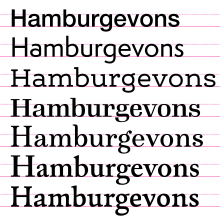Hamburgevons
The word Hamburgevons (or Hamburgefonstiv) is a short piece of filler text used for assessing the design and the appearance of a typeface.[1][2] It contains all essential forms in a latin alphabet, so that the character of the respective font can be recognized quickly.[3][4] It consists of the letters that are often first designed when designing a typeface.[4]

While the word has no meaning, it is useful for typographers and designers during the design of a font, as the form of its letters include all of the curves and abutments normally found in a font.[5][6]
As a test word it is useful for determining the visual readability of a font chosen for a layout.[7][8] One of the three words is often used as a standard word in the visual layout of fonts submitted to competitions and exhibitions.[9][10][11]
Bibliography
Jérôme Peignot, L’Alphabet des lettres, ou le petit hamburgefons, Paris, Imprimerie nationale, 1995, 128 p. (ISBN 978-2940028085).
References
- Der Druckspiegel. 5–8 (in German). 27. Druckspiegel-Fachzeitschriften-Verlags-GmbH. 1972. pp. 256–.
Das untenstehende Modellwort "Hamburgefons" zeigt von der Gill-Grotesk vier verschiedene Laufweiten.
- Gewerblicher Rechtsschutz und Urheberrecht (in German). 84. Verlag Chemie. 1982. pp. 79–.
Nach den Erfahrungen der Fachkreise erfüllten diese Voraussetzungen beispielsweise die Buchstaben des Phantasieworts "Hambur-giensis" (neuerdings auch: „O Hamburgefonstiv"). Diesen Ausführungen hatten sich damals die Mitglieder des mit der Vorbereitung des Abkommens beauftragten Sachverständigenausschusses angeschlossen.
- "Glossary K: key words". Fonts.com. Retrieved 10 February 2019.
- David Machin (30 April 2014). Visual Communication. De Gruyter Mouton. pp. 219–. ISBN 978-3-11-025549-2.
- Simon Garfield (1 September 2011). Just My Type: A Book About Fonts. Penguin Publishing Group. pp. 317–. ISBN 978-1-101-57781-3.
- Janet Ashford; John Odam (January 1996). Start with a Scan: A Guide to Transforming Scanned Photos and Objects Into High Quality Art. Peachpit Press. ISBN 978-0-201-88456-2.
- Steven Heller; Philip B. Meggs (2001). Texts on Type: Critical Writings on Typography. Allworth Press. ISBN 978-1-58115-082-7.
- Steve Byers (1991). The electronic type catalog. Bantam Books. ISBN 978-0-553-35446-1.
- International exhibition of illustration and editorial art. Moravská galerie v Brně. 1988.
- Metropolis. Bellerophon Publications. 1988.
- Ilene Strizver (4 February 2014). Type Rules: The Designer's Guide to Professional Typography. Wiley. pp. 455–. ISBN 978-1-118-75866-3.